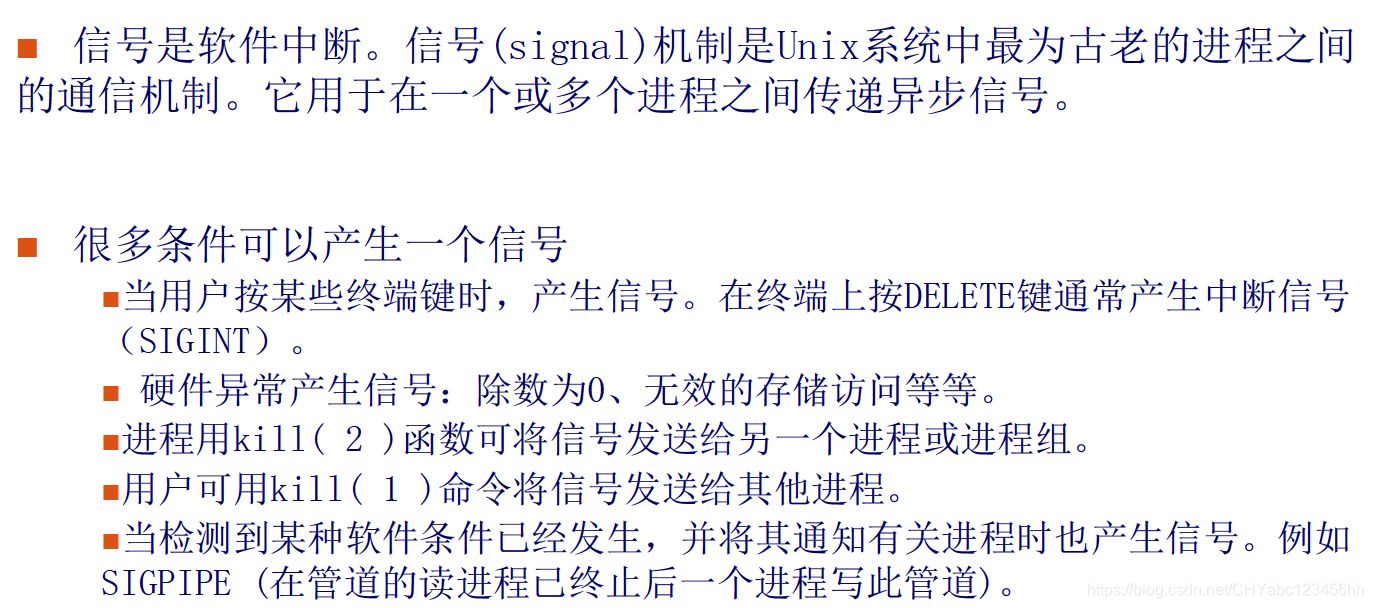


- 2) SIGINT
程序终止(interrupt)信号, 在用户键入INTR字符(通常是Ctrl-C)时发出,用于通知前台进程组终止进程。
- 3) SIGQUIT
和SIGINT类似, 但由QUIT字符(通常是Ctrl-\)来控制. 进程在因收到SIGQUIT退出时会产生core文件, 在这个意义上类似于一个程序错误信号。
- 15) SIGTERM
程序结束(terminate)信号, 与SIGKILL不同的是该信号可以被阻塞和处理。通常用来要求程序自己正常退出,shell命令kill缺省产生这个信号。如果进程终止不了,我们才会尝试SIGKILL。
- 19) SIGSTOP
停止(stopped)进程的执行. 注意它和terminate以及interrupt的区别:该进程还未结束, 只是暂停执行. 本信号不能被阻塞, 处理或忽略.



代码
- 子进程运行到3的时候,会停止,父进程唤醒子进程,子进程接着运行,当子进程到4的时候,中断退出,所有的进程全部结束
#include <sys/types.h>
#include <stdio.h>
#include <unistd.h>
#include <string>
#include <signal.h>
#include <wait.h>int main() {pid_t pid = 0;int ret;int i =1;if ((pid = fork()) < 0) {perror("fork error!\n");exit(1);}if (pid == 0) {printf("children pid = %d\n", getpid());//raise(SIGINT)for (i = 1; i < 10; i++) {sleep(1);printf("children printf %d ...\n", i);if (i == 3) {printf("stop!\n");raise(SIGSTOP);//进程停止信号}if (i == 4) {printf("contine\n");raise(SIGINT);//进程中断信号}printf("本次id = %d\n", i);}printf("children exit!\n");exit(0);} else {printf("children process id = %d\n", pid);printf("father process pid = %d\n", getpid());sleep(5);if ((waitpid(pid, nullptr, WNOHANG)) == 0) {ret = kill(pid, SIGCONT);if (ret == 0)//向子进程发送 继续运行的信号printf("信号发送成功 %d \n", pid);else {perror("信号发送成功 ");}
// printf("\n");}return 0;}
}


- 前面是要捕捉的信号,后面是针对捕捉的信号对应的处理措施,自己写的一个函数


定义自己信号处理函数
#include <sys/types.h>
#include <stdio.h>
#include <unistd.h>
#include <string>
#include <signal.h>
#include <wait.h>void cancel(int aig){printf("当前程序取消了ctrl+C功能\n");
}
int main() {signal(SIGINT,cancel);while (1){printf("*\n");sleep(1);}return 0;
}


代码
#include <sys/types.h>
#include <stdio.h>
#include <unistd.h>
#include <string>
#include <signal.h>
#include <wait.h>void ouch(int aig){printf("OUCH! - I got signal %d\n",aig);
}
int main() {struct sigaction act;act.sa_handler = ouch;//设置信号处理函数sigemptyset(&act.sa_mask);//初始化信号集act.sa_flags = 0;sigaction(SIGINT,&act, nullptr);while (1){printf("Hello World!\n");sleep(1);}return 0;
}

参考链接
- C语言waitpid()函数:中断(结束)进程函数(等待子进程中断或
- C语言sigaction()函数:查询或设置信号处理方式
































